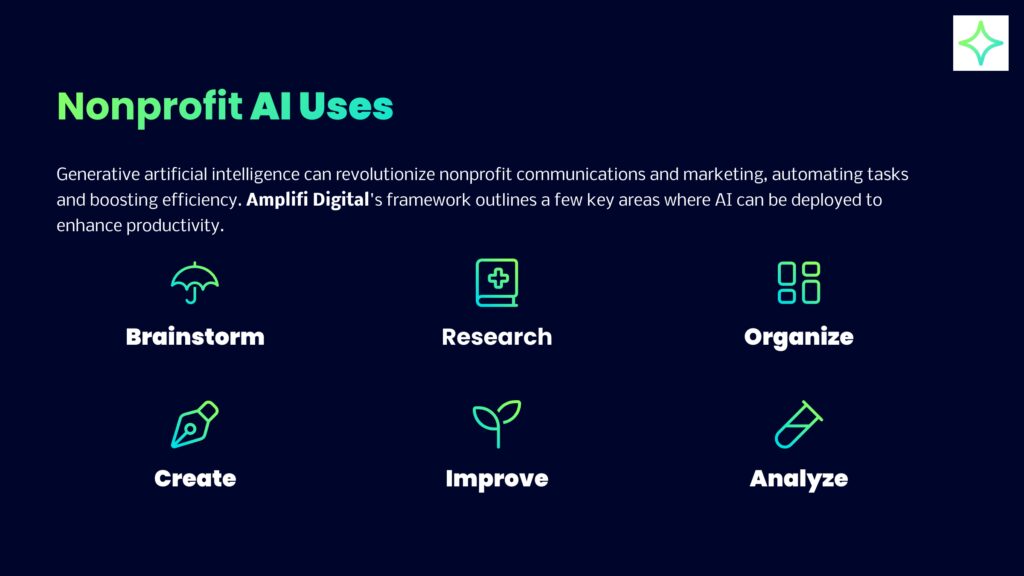
In this conversation about using AI for nonprofit communications, Jamie Lonie, founder of Amplifi Digital and Minerva’s Vice President Sara Veltkamp, discuss tools, ethical considerations, and practical use cases that nonprofit communicators can try to aid their communication efforts.
This conversation has been streamlined using—you guessed it—AI.
Sara: Hey Jamie, so glad we could talk today about AI for nonprofits. To kick us off, why don’t you tell folks who you are and how your company Amplifi Digital support nonprofit organizations?
Jamie: Absolutely. At Amplifi Digital, we equip nonprofits with digital tools and strategies to strengthen their online presence, connect with their communities, and achieve impactful results. We offer consulting and coaching to help them stand out online, engage supporters, and see real growth.
AI fits perfectly into this mission because it’s such a powerful tool for streamlining digital communications, which is why I’m so excited to dive into this conversation today.
Sara: Same here! AI offers so much potential for nonprofit communicators, especially for teams that are juggling multiple roles with limited resources. Delegating some tasks to AI can free up time for creativity and strategy, which are so crucial for the causes we support. How did you first start exploring AI for nonprofit communications?
Jamie: I’ve always been fascinated by emerging tech and how it can be adapted for good. Back in 2022, when ChatGPT released its public free version, I dove in, learning everything I could. I took online courses, spoke with nonprofit leaders experimenting with AI, and tested dozens of use cases to understand how these tools—when used ethically—could help us work smarter and more efficiently.
Sara: That’s such a thoughtful approach. How has that learning shaped how you use AI in your work?
Jamie: AI has become a daily partner in my writing process. For example, I use ChatGPT to draft complex documents like proposals and presentations. By working with the same chat, I’ve trained it to mimic my voice and preferred structure. This helps create solid first drafts faster and ensures nothing gets missed. I’ve also started using a tool called Gamma for presentations—it generates slides based on prompts and even suggests layouts. Huge time-saver, as supporting conversations with slides is my preferred way of talking with clients.
I also use it for feedback, asking it to not only check for technical consistency like grammar or tense but also to give more thoughtful input like asking “What’s missing from this proposal?”
What about you? How are you using AI?
Sara: I’m not a daily user—yet, but I often use it when I’m stuck. If I’m writing a blog, for example, and can’t figure out the ending, I’ll ask ChatGPT to suggest a few options to achieve specific goals. It’s great for breaking through writer’s block. I also use it to simplify jargon-heavy language or rework dense text into plain, web-friendly copy. This helps to cut away inaccessible language and find less wordy or complex ways of conveying the same information.
I also get new ideas from my colleagues all the time. Recently, my colleague tried having ChatGPT analyze a client piece to identify its target audience—it nailed it and explained why that audience may resonate with the piece. I thought that was a wonderful way of using the tool.
I also attended a panel at the Communications Network’s annual conference in 2023 and one communicator who uses English as his second language said that ChatGPT has leveled the playing field for him when it comes to basic email and text communication. Now he can focus more on his ideas than grammar, just like his colleagues who already have the privilege of working in their first language.
Jamie: Those are great examples! There’s so much potential here for nonprofits. That’s why we created NonprofitAI.net. It outlines six starter use cases for nonprofit communications and includes resources and tools we’re developing, like chatbots for brand voice and analytics.

Sara: Love that. Let’s pivot to challenges and ethics. The big ones for me are privacy, protecting proprietary data, AI’s energy use, and misinformation. What’s your take on these?
Jamie: Those are spot-on concerns. I’d add bias and fairness. Many tools have implicit bias built into their outputs because of the data these tools have been trained on. For example, I’ve read that early versions of Siri were trained on Enron’s emails, because all of those emails went public as part of the lawsuits and this big dataset of people talking to each other was available to use. So, a group of predominantly white people in Texas was the foundation of how some of the early voice assistants spoke. Similarly, today’s AI models are trained on information that may also have unintentional built-in biases.
Sara: That reminds me of something I learned from Kentaro Toyama, a researcher in tech and development. He said technology amplifies existing systems—good or bad. We’ve trained AI in the context of broken systems that oppress some groups for the benefit of others—how can we not expect the tools to do the same unless we attempt to correct for these biases?
Jamie: Exactly. These challenges are real, and it’s critical that we continue to build solutions to address them. There is not going to be a quick fix. Despite that, I hope nonprofit leaders remain interested and open to experimenting with how these tools could be useful to make their work more efficient in ways that feel appropriate for their organizations. By using it thoughtfully, we can shape it to align with our values and amplify the good we’re trying to achieve.
Sara: I feel the same way. I do not downplay the real challenges we face in using AI—because of its potential, the proliferation of this technology is inevitable. I want tools to be developed and engaged with by people who care about the challenges and are impacted by them.
Jamie: It’s like Oprah said in a recent ABC News special about AI on Hulu, “This one’s too important to sit out.” Many models learn from everybody’s use so you have a potential positive impact by using it in ways that you think are ethical and teaching it, at least in that moment, what it should and shouldn’t be doing. Only by using it can nonprofit leaders develop perspectives and shape how it’s used and developed moving forward.
Sara: Completely agree. So, for someone new to AI in nonprofit communications, where would you suggest they start?
Jamie: I’d recommend checking out NonprofitAI.net—it’s packed with starter resources specifically for mission-driven communications. Also, spend time learning how to write better prompts for large language models like ChatGPT. Strong prompting skills are transferable across use cases from drafting to research. Finally, explore the many free tools that have a built-in AI component to see what’s possible, understanding that anything you create or put out into the world using these tools may be accessible to others or used to improve the tools. In short, next time you have a new project to embark on, why not “try with AI” as a partner?
Sara: Thanks for this insightful conversation, Jamie. It’s clear AI presents both exciting opportunities and important challenges for nonprofit communicators.
Jamie: Absolutely, Sara. My parting thought is this: AI isn’t a magic fix nor a replacement, but it can be a powerful ally when used thoughtfully and ethically. For nonprofits, staying curious and experimenting with these tools—while keeping your organization’s mission and values front and center—will help us harness their potential responsibly.
